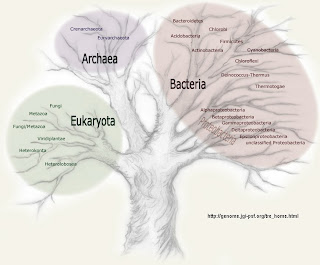 All cells are capable of making glucose. The pathways is called gluconeogenesis and the end product is not actually glucose but a phosphorylated intermediate called glucose-6-phosphate.
All cells are capable of making glucose. The pathways is called gluconeogenesis and the end product is not actually glucose but a phosphorylated intermediate called glucose-6-phosphate.Glucose-6-phosphate (G6P) serves as the precursor for synthesis of many other compounds such as the ribose sugars needed in making DNA and RNA. The only organisms that make free glucose are multicellular organisms, such as animals, that secrete it into the circulatory system so it can be taken up and used by other cells (Glucose-6-phosphate cannot diffuse across the membrane so it's retained within cells.)
In times of plenty, G6P may not be needed in further biosynthesis reactions so cells have evolved a way of storing, or banking, excess glucose. The stored glucose molecules can then be retrieved when times get tough. Think of bacteria growing in the ocean, for example. There may be times when an abundant supply of CO2 combined with a surplus of inorganic energy sources (e.g., H2S) allows for synthesis of lots of G6P. These cells can store the excess G6P by making glycogen—a polymer of glucose residues.

 Glycogen consists of long chains of glucose molecules joined end-to-end through their carbon atoms at the 1 and 4 positions. The chains can have many branches. Completed chains can have up to 6000 glucose residues making glycogen one of the largest molecules in living cells.
Glycogen consists of long chains of glucose molecules joined end-to-end through their carbon atoms at the 1 and 4 positions. The chains can have many branches. Completed chains can have up to 6000 glucose residues making glycogen one of the largest molecules in living cells.The advantage of converting G6P to glycogen is that it avoids the concentration effects of having too many small molecules floating around inside the cell. By compacting all these molecules into a single large polymer the cell is able to form large granules of stored sugar (see photo above).
The first step in the synthesis of glycogen is the conversion of glucose-6-phosphate to glucose-1-phosphate by the action of an enzyme called phosphoglucomutase. (Mutases are enzymes that rearrange functional groups, in this case moving a phosphate from the 6 position of glucose to the 1 position.) The glycogen synthesis reaction requires adding new molecules that will be connected to the chain through their #1 carbon atoms so this preliminary reaction is required in order to "activate" the right end of the glucose residue.
 Glucose-1-phosphate is the "Cori ester" [Monday's Molecule #25] that was discovered by Carl Cori and Gerty Cori while they were working out this pathway [Nobel Laureates: Carl Cori and Gerty Cori].
Glucose-1-phosphate is the "Cori ester" [Monday's Molecule #25] that was discovered by Carl Cori and Gerty Cori while they were working out this pathway [Nobel Laureates: Carl Cori and Gerty Cori].The next step is the conversion of glucose-1-phosphate to the real activated sugar, UDP-glucose. The enzyme is UDP-glucose pyrophosphorylase and the UDP-glucose product is similar to many other compound that are activated by attaching a nucleotide. In some bacteria, the activated sugar is ADP-glucose but the enzyme is the same as that found in eukaryotes. ADP-glucose is the activated sugar in plants, as well. In plants the storage molecules are starch, not glycogen, but the difference is small (starch has fewer branches).
 Glycogen synthesis is a polymerization reaction where glucose units in the form of UDP-glucose are added one at a time to a growing polysaccharide chain. The reaction is catalyzed by glycogen synthase.
Glycogen synthesis is a polymerization reaction where glucose units in the form of UDP-glucose are added one at a time to a growing polysaccharide chain. The reaction is catalyzed by glycogen synthase.
[©Laurence A. Moran. Some of the text is from Principles of Biochemistry 4th ed. ©Pearson/Prentice Hall]












































